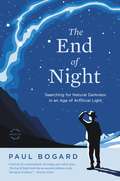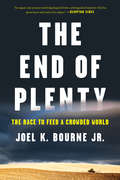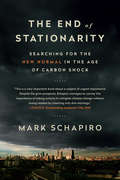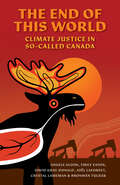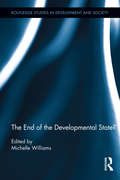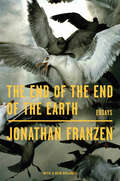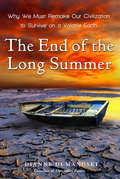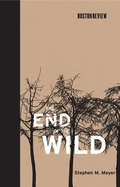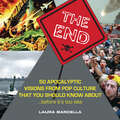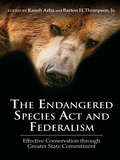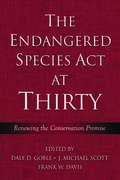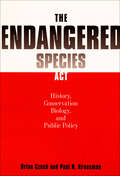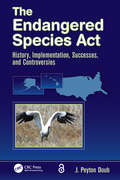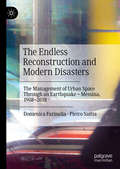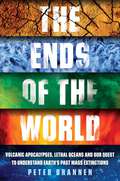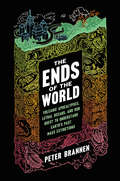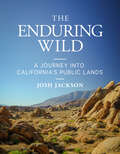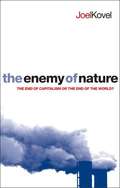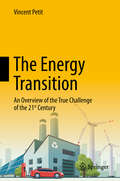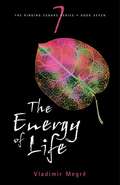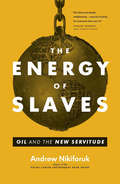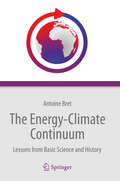- Table View
- List View
The End of Night: Searching for Natural Darkness in an Age of Artificial Light
by Paul BogardA deeply panoramic tour of the night, from its brightest spots to the darkest skies we have left. A starry night is one of nature's most magical wonders. Yet in our artificially lit world, three-quarters of Americans' eyes never switch to night vision and most of us no longer experience true darkness. In THE END OF NIGHT, Paul Bogard restores our awareness of the spectacularly primal, wildly dark night sky and how it has influenced the human experience across everything from science to art. From Las Vegas' Luxor Beam--the brightest single spot on this planet--to nights so starlit the sky looks like snow, Bogard blends personal narrative, natural history, science, and history to shed light on the importance of darkness--what we've lost, what we still have, and what we might regain--and the simple ways we can reduce the brightness of our nights tonight.
The End of Plenty: The Race to Feed a Crowded World
by Joel K. Bourne JrAn award-winning environmental journalist introduces a new generation of farmers and scientists on the frontlines of the next green revolution. When the demographer Robert Malthus (1766-1834) famously outlined the brutal relationship between food and population, he never imagined the success of modern scientific agriculture. In the mid-twentieth century, an unprecedented agricultural advancement known as the Green Revolution brought hybrid seeds, chemical fertilizers, and improved irrigation that drove the greatest population boom in history--but left ecological devastation in its wake. In The End of Plenty, award-winning environmental journalist Joel K. Bourne Jr. puts our race to feed the world in dramatic perspective. With a skyrocketing world population and tightening global grain supplies spurring riots and revolutions, humanity must produce as much food in the next four decades as it has since the beginning of civilization to avoid a Malthusian catastrophe. Yet climate change could render half our farmland useless by century's end. Writing with an agronomist's eye for practical solutions and a journalist's keen sense of character, detail, and the natural world, Bourne takes readers from his family farm to international agricultural hotspots to introduce the new generation of farmers and scientists engaged in the greatest challenge humanity has ever faced. He discovers young, corporate cowboys trying to revive Ukraine as Europe's breadbasket, a Canadian aquaculturist channeling ancient Chinese traditions, the visionary behind the world's largest organic sugar-cane plantation, and many other extraordinary individuals struggling to increase food supplies--quickly and sustainably--as droughts, floods, and heat waves hammer crops around the globe. Part history, part reportage and advocacy, The End of Plenty is a panoramic account of the future of food, and a clarion call for anyone concerned about our planet and its people.
The End of Stationarity: Searching for the New Normal in the Age of Carbon Shock
by Mark SchapiroScientists have devised a new term to explain the turmoil caused by climate change: the end of stationarity. It means that our baselines for rainfall, water flow, temperature, and extreme weather are no longer relevant--that making predictions based on past experience is no longer possible. But climate change has upended baselines in the financial world, too, disrupting the global economy in ways that are just becoming clear, leaving us unable to assess risk, and causing us to fundamentally re-think economic priorities and existing business models. At the heart of that financial unrest is the role of carbon, and as the world moves toward making more and more polluters pay to emit it, a financial mystery unfolds: What are the costs? Who has the responsibility to pay for them? Who do you pay? How do you pay? And how will those costs ripple through the economy? These are the questions veteran journalist Mark Schapiro attempts to answer as he illuminates the struggle to pinpoint carbon's true costs and allocate them fairly--all while bumping up against the vagaries of the free market, the lobbying power of corporations, the political maneuverings of countries, and the tolerance of everyday consumers buying a cup of coffee, a tank of gas, or an airplane ticket. Along the way, Schapiro tracks the cost of carbon through the drought-ridden farmland of California, the jungles of Brazil, the world's greatest manufacturing center in China, the carbon-trading center of Europe, and the high-tech crime world that carbon markets have inspired. He even tracks the cost of carbon through the skies themselves, where efforts to put a price tag on the carbon left by airplanes in the no-man's land of the atmosphere created what amounted to a quiet but powerful global trade war. The End of Stationarity deftly depicts the wild, new carbon economy, and shows us how nations, emerging and developed, teeter on its brink. Originally published in hardcover as Carbon Shock, the book is updated throughout and includes a new afterword, based on the Paris climate talks.
The End of This World: Climate Justice in So-Called Canada
by Emily Eaton Angele Alook David Gray-Donald Joël Laforest Crystal Lameman Bronwen TuckerThe climate crisis is here, and the end of this world—a world built on land theft, resource extraction, and colonial genocide—is on the horizon. In this compelling roadmap to a livable future, Indigenous sovereignty and climate justice go hand in hand. Drawing on their work in Indigenous activism, the labour movement, youth climate campaigns, community-engaged scholarship, and independent journalism, the six authors challenge toothless proposals and false solutions to show that a just transition from fossil fuels cannot succeed without the dismantling of settler capitalism in Canada. Together, they envision a near future where oil and gas stay in the ground; where a caring economy provides social supports for all; where wealth is redistributed from the bloated billionaire class; and where stolen land is rightfully reclaimed under the jurisdiction and sovereignty of Indigenous peoples. Packed with clear-eyed analysis of both short- and long-term strategies for radical social change, The End of This World promises that the next world is within reach and worth fighting for.
The End of the Developmental State?: End Of The Developmental State? (Routledge Studies in Development and Society)
by Michelle WilliamsThe End of the Developmental State? brings together leading scholars of development to assess the current status of the "developmental state" in several developing and transitional economies of South Korea, Taiwan, Ireland, the United Kingdom, China, South Africa, Brazil and India. Has the concept of the developmental state become outmoded? These authors would suggest not. However, they do argue that the historical trajectories of developmental states in Asia, Latin America, Africa and Europe suggest all too clearly that the concept must be re-examined critically and creatively. The range and diversity of their positions and their rejection of stale programmatic positions from the past will revitalize the debate on the role of the state in social and economic transformation in the twenty-first century. By bringing together careful comparative analyses of national cases, in both the Global North and South, the volume highlights pivotal conditions – economic restructuring, domestic politics, epistemic shifts and ecological limits – that are forcing revision of the goals and strategies of developmental states and suggests that states that ignore these new conditions will indeed see the "end of the developmental state".
The End of the End of the Earth: Essays
by Jonathan FranzenFrom Jonathan Franzen, one of our preeminent writers and thinkers, comes a brilliant, searing essay collection that calls for us to take better care of our planet and one another in these troubled times.The End of the End of the Earth is a collection of Jonathan Franzen's essays and speeches from the past five years, in which he grapples with the most important and heated ethical subjects of the day: environmentalism, capitalism, wealth inequality, race, technology and the role of art. He challenges us to ask difficult questions: What is our civic responsibility in the face of climate change, the greatest ever threat to our planet and species? Does technology give us a sense of control or community or is it stripping these from us? Above all, in these essays, Franzen asks us to care--about causes great and small, with subjects as big as our planet and specific as a rare species of birds. These essays are in praise of empathy, and of the beauty and power of nature and art.This slim but powerful book is Franzen at his best, incisive, persuasive and compassionate.
The End of the End of the Earth: Essays
by Jonathan FranzenFrom Jonathan Franzen, one of our preeminent writers and thinkers, comes a brilliant, searing essay collection that calls for us to take better care of our planet and one another in these troubled times.The End of the End of the Earth is a collection of Jonathan Franzen's essays and speeches from the past five years, in which he grapples with the most important and heated ethical subjects of the day: environmentalism, capitalism, wealth inequality, race, technology and the role of art. He challenges us to ask difficult questions: What is our civic responsibility in the face of climate change, the greatest ever threat to our planet and species? Does technology give us a sense of control or community or is it stripping these from us? Above all, in these essays, Franzen asks us to care--about causes great and small, with subjects as big as our planet and specific as a rare species of birds. These essays are in praise of empathy, and of the beauty and power of nature and art.This slim but powerful book is Franzen at his best, incisive, persuasive and compassionate.
The End of the Long Summer: Why We Must Remake Our Civilization to Survive On A Volatile Earth
by Dianne DumanoskiFor the past twelve thousand years, Earth’s stable climate has allowed human civilization to flourish. But this long benign summer is an anomaly in the Earth’s history and one that is rapidly coming to a close. The radical experiment of our modern industrial civilization is now disrupting our planet’s very metabolism; our future hinges in large part on how Earth responds. Climate change is already bearing down, hitting harder and faster than expected. The greatest danger is not extreme yet discrete weather events, such as Hurricane Katrina or the calamitous wildfires that now plague California, but profound and systemic disruptions on a global scale. Contrary to the pervasive belief that climate change will be a gradual escalator ride into balmier temperatures, the Earth’s climate system has a history of radical shifts–dramatic shocks that could lead to the collapse of social and economic systems. The question is no longer simply how can we stop climate change, but how can we as a civilization survive it. The guiding values of modern culture have become dangerously obsolete in this new era. Yet as renowned environmental journalist Dianne Dumanoski shows, little has been done to avert the crisis or to prepare human societies for a time of growing instability. In a work of astonishing scope, Dumanoski deftly weaves history, science, and culture to show how the fundamental doctrines of modern society have impeded our ability to respond to this crisis and have fostered an economic globalization that is only increasing our vulnerability at this critical time. She exposes the fallacy of banking on a last-minute technological fix as well as the perilous trap of believing that humans can succeed in the quest to control nature. Only by restructuring our global civilization based on the principles that have allowed Earth’s life and our ancestors to survive catastrophe——diversity, redundancy, a degree of self-sufficiency, social solidarity, and an aversion to excessive integration——can we restore the flexibility needed to weather the trials ahead. In this powerful and prescient book, Dumanoski moves beyond now-ubiquitous environmental buzzwords about green industries and clean energy to provide a new cultural map through this dangerous passage. Though the message is grave, it is not without hope. Lucid, eloquent, and urgent,The End of the Long Summerdeserves a place alongside transformative works such asSilent SpringandThe Fate of the Earth. From the Hardcover edition.
The End of the Wild
by Stephen M. MeyerToday the guiding hand of natural selection is unmistakably human. With these words Stephen M. Meyer begins a stunningly clear-eyed view of the extinction crisis. Marshaling evidence from the last ten years of research, he argues that nothing-not national or international laws, global bioreserves, local sustainability schemes, or "wildlands"-will change the course we have set: the loss of half of the earth's species by the end of the century. We will come to share the planet only with species that thrive in human-dominated environments.
The End of the Wild (Boston Review)
by Stephen M. MeyerA wake-up call that argues that although it may be too late to save biodiversity, we can take steps to save our ecosystems. With the extinction rate at 3000 species a year and accelerating, we can now predict that as many as half of the Earth's species will disappear within the next 100 years. The species that survive will be the ones that are most compatible with us: the weedy species—from mosquitoes to coyotes—that thrive in continually disturbed human-dominated environments. The End of the Wild is a wake-up call. Marshaling evidence from the last ten years of research on the environment, Stephen Meyer argues that nothing—not national or international laws, global bioreserves, local sustainability schemes, or "wildlands"—will change the course that has been set. Like it or not, we can no longer talk about conserving nature, only managing what is left. The race to save biodiversity is over. But that doesn't mean our work is over. The End of the Wild is also a call to action. Without intervention, the surviving ecosystems we depend on for a range of services—including water purification and flood and storm damage contro—could fail and the global spread of invasive species (pests, parasites, and disease-causing weedy species) could explode. If humanity is to survive, Meyer argues, we have no choice but to try to manage the fine details. We must move away from the current haphazard strategy of protecting species in isolation and create trans-regional "meta-reserves," designed to protect ecosystem functions rather than species-specific habitats.
The End: 50 Apocalyptic Visions From Pop Culture That You Should Know About...Before It's Too Late
by Laura BarcellaPeople have been making predictions about how and when the world is going to end for ages. The End is a fun pop culture read about the top 50 movies, books, songs, and artworks—from the movie Shaun of the Dead to the song It's the End of the World as We Know It—about the apocalypse. Each item includes: - A synopsis of the apocalyptic work - Information about the apocalyptic theory behind it (from alien invasion to meteors, nuclear war, and natural disasters) - An explanation about why this work is important in pop culture Love doomsday talk and the art made about it? Check out this fun and entertaining read!
The Endangered Species Act and Federalism: Effective Conservation through Greater State Commitment
by Jr. Barton H. Thompson Kaush ArhaStates today play a major role in implementing and enforcing environmental laws such as the Clean Air Act, Clean Water Act, and the Resource Conservation and Recovery Act. A thirty year review of ESA identified state leadership in species conservation as a necessary element in better conserving the nation‘s imperiled species, yet the theoretical and practical reasons and applications of an enhanced state role are little understood and have not been subjected to any meaningful analysis. This book, for the first time, presents the legal and policy analysis for federalism considerations in implementing ESA. The book undertakes a comprehensive analysis of the economic rationale for federalism in ESA administration; compares administration of ESA to other major environmental statutes; reviews various tools under the existing Act to enhance state role in species conservation; evaluates major case studies to determine roles the state can play in species conservation and recovery; and concludes with policy recommendations to encourage greater state involvement in species conservation.
The Endangered Species Act at Thirty: Renewing the Conservation Promise
by Dale D. Goble J. Michael Scott Frank W. DavisThe Endangered Species Act at Thirty is a comprehensive, multidisciplinary review of issues surrounding the Endangered Species Act, with a specific focus on the act's actual implementation record over the past thirty years. The result of a unique, multi-year collaboration among stakeholder groups from across the political spectrum, the two volumes offer a dispassionate consideration of a highly polarized topic. Renewing the Conservation Promise, Volume 1, puts the reader in a better position to make informed decisions about future directions in biodiversity conservation by elevating the policy debate from its current state of divisive polemics to a more-constructive analysis. It helps the reader understand how the Endangered Species Act has been implemented, the consequences of that implementation, and how the act could be changed to better serve the needs of both the species it is designed to protect and the people who must live within its mandates. Volume 2, which examines philosophical, biological, and economic dimensions of the act in greater detail, will be published in 2006. As debate over reforming the Endangered Species Act heats up in the coming months, these two books will be essential references for policy analysts and lawmakers; professionals involved with environmental law, science, or management; and academic researchers and students concerned with environmental law, policy, management, or science.
The Endangered Species Act: History, Conservation Biology and Public Policy
by Brian Czech Paul R KrausmanThe new model of policy design theory frames the discussion regarding the frequently analyzed Endangered Species Act in this historical perspective.Since the 1970s, the Endangered Species Act (ESA), by virtue of its regulatory impact, has been a frequent subject of policy analysis. In this comprehensive history and critique of the ESA, Brian Czech and Paul R. Krausman incorporate the new model of policy design theory to frame a larger discussion about conservation biology and American democracy. Czech and Krausman provide a historical background of endangered species policy that integrates natural history, socioeconomic trends, political movements, and professional developments. Outlining the controversies surrounding the ESA, they find a connection between challenges to species conservation and challenges to democracy. After an assessment of ESA analyses that have been performed from traditional perspectives, they engage policy design theory to review the structural logic of the ESA, analyzing each clause of the legislation for its application of the fundamental elements of democracy. To address the technical legitimacy of ESA, they propose two new genetic considerations-functional genome size and molecular clock speed-to supplement phylogenetic distinctiveness as criteria with which to prioritize species for conservation. Next, they systematically describe the socioeconomic context of ESA by assessing and classifying the causes of species endangerment. A hybrid of policy analysis and ecological assessment, The Endangered Species Act: History, Conservation Biology, and Public Policy will appeal to scholars and students in the fields of natural resource policy and law, conservation biology, political science, wildlife ecology, and environmental history, and to professionals at agencies involved in wildlife conservation.“Interesting for anyone concerned about the preservation of species and, more generally, the global environment . . . a good explanation of the statute, a wonderful and often entertaining description of how we view and rank nonhuman species, and a provocative critique of the very policy analytic framework the authors have employed.” —Joseph F. C. DiMento Environment“Czech and Krausman are effective and original scholars. The Endangered Species Act: History, Conservation Biology, and Public Policy is both a treatise on policy assessment and an excellent history, assessment, and discussion of the ESA itself. Those interested in natural resources policy and those interested specifically in the ESA will want to read this book.” —Jack Ward Thomas, The University of Montana, Chief Emeritus, U.S. Forest Service
The Endangered Species Act: History, Conservation Biology, and Public Policy
by Brian Czech Paul R. KrausmanThe new model of policy design theory frames the discussion regarding the frequently analyzed Endangered Species Act (ESA) in this historical perspective.Since the 1970s, the Endangered Species Act (ESA), by virtue of its regulatory impact, has been a frequent subject of policy analysis. In this comprehensive history and critique of the ESA, Brian Czech and Paul R. Krausman incorporate the new model of policy design theory to frame a larger discussion about conservation biology and American democracy.Czech and Krausman provide a historical background of endangered species policy that integrates natural history, socioeconomic trends, political movements, and professional developments. Outlining the controversies surrounding the ESA, they find a connection between challenges to species conservation and challenges to democracy. After an assessment of ESA analyses that have been performed from traditional perspectives, they engage policy design theory to review the structural logic of the ESA, analyzing each clause of the legislation for its application of the fundamental elements of democracy. To address the technical legitimacy of ESA, they propose two new genetic considerations—functional genome size and molecular clock speed—to supplement phylogenetic distinctiveness as criteria with which to prioritize species for conservation. Next, they systematically describe the socioeconomic context of ESA by assessing and classifying the causes of species endangerment.A hybrid of policy analysis and ecological assessment, The Endangered Species Act: History, Conservation Biology, and Public Policy will appeal to scholars and students in the fields of natural resource policy and law, conservation biology, political science, wildlife ecology, and environmental history, and to professionals at agencies involved in wildlife conservation.
The Endangered Species Act: History, Implementation, Successes, and Controversies
by J. Peyton DoubThe complex regulations of the Endangered Species Act can be challenging for environmental professionals who must comply with them or assist clients in compliance. This volume discusses the Act using clear scientific prose that all professionals can readily comprehend. It explores the history and the basic scientific theory underlying the Act. It provides an overview of its key provisions and examines the Act in the context of other key environmental planning statutes. The book also details the regulatory processes faced by other government agencies and private developers who must routinely ensure that their actions are in compliance.
The Endless Reconstruction and Modern Disasters: The Management of Urban Space Through an Earthquake – Messina, 1908–2018 (Disaster Studies)
by Domenica Farinella Pietro SaittaThis is a study on the long-lasting consequences of a disastrous earthquake that hit the city of Messina, Sicily, in 1908. The quake killed about 86,000 people, and destroyed one of the most important portal cities of the Mediterranean. The book investigates both the forces that shaped that event and made it possible – firstly, urban speculation processes at the end of the nineteenth century – and the role of that occurrence in creating a complex event that, on the one hand, accelerated trends and tendencies that were already in motion; and, on the other, produced an entirely new social space based on social separation and the raise of a widespread marginal class. Such a class developed within urban borders and spaces that, over the decades, grew according to the same logic and directions that followed the reconstruction. Especially the shacks, still a visible presence in the city, represent the lieu of reproduction both of a class and the whole of the social relations stemming from the disaster.It shows how key-concepts in contemporary scientific analysis, such as “shock economy” and “economy of disaster,” can be aptly backdated. Above all, this study broadens the normal analyses of disasters by showing the stratification of institutional techniques and economic forces that, over the decades, intervened and (re-)shaped the site of a disaster and its social structure.
The Ends of the World: Volcanic Apocalypses, Lethal Oceans and Our Quest to Understand Earth’s Past Mass Extinctions
by Peter BrannenApocalypse, now? Death by fire, ice, poison gas, suffocation, asteroid. At five moments through history life on Earth was dragged to the very edge of extinction. Now, armed with revolutionary technology, scientists are uncovering clues about what caused these catastrophes. Deep-diving into past worlds of dragonflies the size of seagulls and fishes with guillotines for mouths, they explore how – against all the odds – life survived and what these ominous chapters can tell us about our future.
The Ends of the World: Volcanic Apocalypses, Lethal Oceans, and Our Quest to Understand Earth's Past Mass Extinctions
by Peter BrannenAs new groundbreaking research suggests that climate change played a major role in the most extreme catastrophes in the planet's history, award-winning science journalist Peter Brannen takes us on a wild ride through the planet's five mass extinctions and, in the process, offers us a glimpse of our increasingly dangerous future Our world has ended five times: it has been broiled, frozen, poison-gassed, smothered, and pelted by asteroids. In The Ends of the World, Peter Brannen dives into deep time, exploring Earth’s past dead ends, and in the process, offers us a glimpse of our possible future.Many scientists now believe that the climate shifts of the twenty-first century have analogs in these five extinctions. Using the visible clues these devastations have left behind in the fossil record, The Ends of the World takes us inside “scenes of the crime,” from South Africa to the New York Palisades, to tell the story of each extinction. Brannen examines the fossil record—which is rife with creatures like dragonflies the size of sea gulls and guillotine-mouthed fish—and introduces us to the researchers on the front lines who, using the forensic tools of modern science, are piecing together what really happened at the crime scenes of the Earth’s biggest whodunits.Part road trip, part history, and part cautionary tale, The Ends of the World takes us on a tour of the ways that our planet has clawed itself back from the grave, and casts our future in a completely new light.
The Enduring Wild: A Journey into California's Public Lands
by Josh JacksonA galvanizing road trip across California's immense public wilderness from a beloved adventurer."The Enduring Wild is a call to look beyond the surface, embrace the deep connections that tie us to our public lands, and commit to safeguarding them for future generations." —QT Luong, author of Treasured Lands: A Photographic Odyssey Through America's National ParksIt all began with a camping trip. Outdoor enthusiast Josh Jackson had never heard of "BLM land" before a casual recommendation from a friend led him to a free campsite in the desert—and the revelation that over 15 million acres of land in California are owned collectively by the people. In The Enduring Wild, he takes us on a road trip spanning thousands of miles, crisscrossing the Golden State to seek out every parcel of public wilderness therein belonging to the federal Bureau of Land Management, from the Pacific shores of the King Range down to the Mojave Desert. Over mountains, across prairies, and through sagebrush, Jackson unravels the stories of these lands. He tells of the Indigenous peoples who have called them home for millennia, of the extractivist threats that imperil them today, and of the grassroots organizers and political champions who have rallied to their common defense to uphold the radical mandate to protect these natural treasures for generations to come. For the adventurers, campers, explorers, map readers, road trippers, nature enthusiasts, and public lands lovers out there, The Enduring Wild is an indispensable invitation to know these places more deeply and to embrace our common inheritance. Illustrations by Rebekah Nolan.
The Enemy Of Nature: The End Of Capitalism Or The End Of The World?
by Joel KovelWe live in and from nature, but the way we have evolved of doing this is about to destroy us. Capitalism and its by-products - imperialism, war, neoliberal globalization, racism, poverty and the destruction of community - are all playing a part in the destruction of our ecosystem. <p><p> Only now are we beginning to realise the depth of the crisis and the kind of transformation which will have to occur to ensure our survival. This second, thoroughly updated, edition of The Enemy of Nature speaks to this new environmental awareness. Joel Kovel argues against claims that we can achieve a better environment through the current Western 'way of being'. By suggesting a radical new way forward, a new kind of 'ecosocialism', Joel Kovel offers real hope and vision for a more sustainable future.
The Energy Transition
by Vincent PetitAgainst the backdrop of rapid advances in the energy sector, this book provides a concise overview of the complex challenges in the energy paradigm today, which revolve around the seemingly unsolvable energy equation. The author, an experienced energy professional, combines the various aspects of the energy transition into a single perspective. While highlighting a number of salient problems, he also explores grounds for optimism that these challenges can and will be met. After establishing the historical context, the book presents an analysis of today's energy industry, different energy sources, countries and determinants of energy demand, supplementing all sections with a wealth of global and local data. It subsequently proposes measures to solve the energy equation and a roadmap for a sustainable future, based on more efficient energy use, cleaner energy production and advanced technologies.
The Energy of Life (The Ringing Cedars Series #7)
by Vladimir Megré John Woodsworth Leonid SharashkinMan's life! On what or on whom does it depend? Why do some become emperors or regimental commanders, while others are obliged to fend for scraps at garbage dumps? One opinion holds that each person's fate is pre-determined from birth. That would make Man nothing more than an insignificant cog in some mechanised system, and not the highly organised creation of God.
The Energy of Slaves: Oil and the New Servitude
by Andrew Nikiforuk&“A robustly researched and smoothly written overview of the many challenges confronting our devotion to fossil fuels&” from the author of Tar Sands (Quill & Quire). Ancient civilizations relied on shackled human muscle. It took the energy of slaves to plant crops, clothe emperors, and build cities. Nineteenth-century slaveholders viewed critics as hostilely as oil companies and governments now regard environmentalists. Yet the abolition movement had an invisible ally: coal and oil. As the world&’s most versatile workers, fossil fuels replenished slavery&’s ranks with combustion engines and other labor-saving tools. Since then, cheap oil has transformed politics, economics, science, agriculture, and even our concept of happiness. Many North Americans today live as extravagantly as Caribbean plantation owners. We feel entitled to surplus energy and rationalize inequality, even barbarity, to get it. But endless growth is an illusion. In this provocative book, Andrew Nikiforuk, winner of the Rachel Carson Environment Book Award, argues that what we need is a radical emancipation movement that ends our master-and-slave approach to energy. We must learn to use energy on a moral, just, and truly human scale. Published in Partnership with the David Suzuki Institute &“In his cautionary tale about the evils of oil . . . Nikiforuk makes his case for impending doom if we don&’t mend our energy-spending ways.&” —The Star &“In this cogently argued book, Andrew Nikiforuk deploys a powerful metaphor. Oil dependency, he writes, is a modern form of slavery—and it&’s time for a global abolition movement.&” —Taras Grescoe, author of Shanghai Grand &“A startling critique that should rouse us from our pipe dream of endless plenty.&” —Ronald Wright, author of On Fiji Islands
The Energy-Climate Continuum
by Antoine BretThis book puts the debates about the energy-climate continuum on a scientific ground! It is a must-read for everyone, who wants to understand how intimately the energy and climate debates are linked to each other, and who wants to participate in these omnipresent discussions. Antoine Bret explains in his book how fossil fuels became indispensable for our society. He carefully explains how and why this impacts the earth's climate. And he points out that all available fossil fuels will sooner or later be used up. Therefore, he introduces and discusses the alternatives, which are currently considered. The book is divided into three parts. The first part explains the problem and where we stand today, the second part critically discusses possible elements of solution. The third part illustrates historic case studies, containing both warning as well as encouraging examples of societies at turning points. This book is a careful introduction to these topics. The basic science behind the problem and the debates are introduced in an understandable and nicely readable fashion. Facts are illustrated with simple back-on-the-envelope calculations, providing a good feeling for orders of magnitudes. A rich appendix provides additional background information for the interested readers. In this way, the book can even be a valuable resource for introductory university courses in physics, climate science, natural science and many more subjects. This book is a real conversation starter and can be recommended to everyone, specialist or non-specialist, who wants to understand the actual energy-climate debates and maybe even involve.
